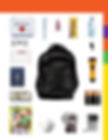Excerpted from a message from Brooklyn South Community Affairs Unit.

New York City Office of Emergency Management recommends that all New Yorkers have a Go Bag: a collection of things you would want if you had to leave in a hurry due to an emergency, disaster, or impending event, like a hurricane. (NYC's hurricane season runs from August 1 to November 1.)
Your Go Bag should be sturdy and easy to carry, like a backpack or a small suitcase on wheels. You'll need to customize your Go Bag for your personal needs, but some of the important things you need in your Go Bag should include:
Copies of your important documents in a waterproof and portable container (insurance cards, birth certificates, deeds, photo IDs, proof of address, etc.)
Extra set of car and house keys
Copies of credit/ATM cards Cash (in small bills)
Bottled water and nonperishable food, such as energy or granola bars
Flashlight Battery-operated AM/FM radio
Extra batteries/chargers
A list of the medications each member of your household takes, why they take them, and their dosages. If you store extra medication in your Go Bag, be sure to refill it before it expires. Get prescription preparedness tips from the NYC Department of Health & Mental Hygiene First-aid kit
Toiletries
Notepad and pen
Contact and meeting place information for your household, and a small regional map
Lightweight rain gear and Mylar blanket
If you have children, pack child care supplies as well as games and small toys.
If you're older or have any special medical needs, consider including these items:
Instructions and extra batteries for any devices you use
Aerosol tire repair kits and/or tire inflator to repair flat wheelchair or scooter tires
Back-up medical equipment Items to comfort you in a stressful situation
If you have a pet, you need to pack a Go Bag for them:
A current color photograph of you and your pet together (in case you are separated)
Copies of medical records that indicate dates of vaccinations and a list of medications your pet takes and why he or she takes them
Proof of identification and ownership, including copies of registration information, adoption papers, proof of purchase, and microchip information
Physical description of your pet, including species, breed, age, sex, color, distinguishing traits, and any other vital information about characteristics and behavior
Animal first aid kit, including flea and tick treatment and other items recommended by your veterinarian
Food and water for at least three days
Food and water dishes
Collapsible cage or carrier
Muzzle* and sturdy leash (*Note: Nylon muzzles should only be used temporarily as they can restrict a dog's ability to pant)
Cotton sheet to place over the carrier to help keep your pet calm
Comforting toys or treats
Litter, litter pan, and litter scoop
Plastic bags for clean-up
Emergency Supply Kit:
Keep enough supplies in your home to survive on your own, or shelter in place, for up to seven days. If possible, keep these materials in an easily accessible, separate container or special cupboard. You should indicate to your household members that these supplies are for emergencies only. Check expiration dates of food and update your kits when you change your clock during daylight saving times.
One gallon of drinking water per person per day
Nonperishable, ready-to-eat canned foods and manual can opener
First-aid kit
Flashlight (Note: Traditional flashlight bulbs have limited lifespans. Light Emitting Diode (LED) flashlights, however, are more durable and last up to 10 times longer than traditional bulbs.)
Battery-operated AM/FM radio and extra batteries (you can also buy wind-up radios that do not require batteries)
Whistle
Iodine tablets or one quart of unscented bleach (for disinfecting water ONLY if directed to do so by health officials) and eyedropper (for adding bleach to water)
Personal hygiene items: soap, feminine hygiene products, toothbrush and toothpaste, etc.
Phone that does not rely on electricity
Child care supplies or other special care items
Regardless of the season, it's a good idea to prepare for an in-car emergency:
Assemble an emergency supply kit for your vehicle, and consider adding the following items for winter conditions:
Blankets, sleeping bags, extra newspapers for insulation
Plastic bags (for sanitation)
Extra mittens, socks, scarves and hat, raingear and extra clothes
Sack of sand or kitty litter for gaining traction under wheels, small shovel
Set of tire chains or traction mats
Working jack and lug wrench, spare tire
Windshield scraper, broom
Small tools (pliers, wrench, screwdriver)
Booster cables
Brightly colored cloth to use as a flag, flares or reflective triangles
Like this article?
Sign up here for our newsletter.
